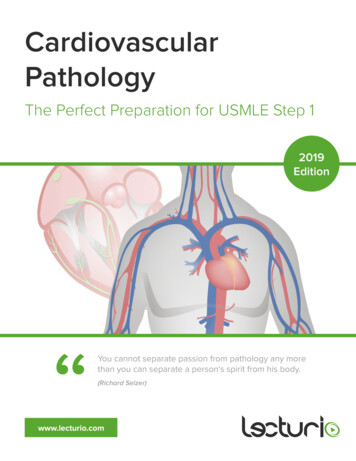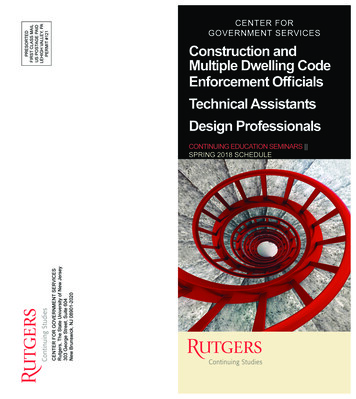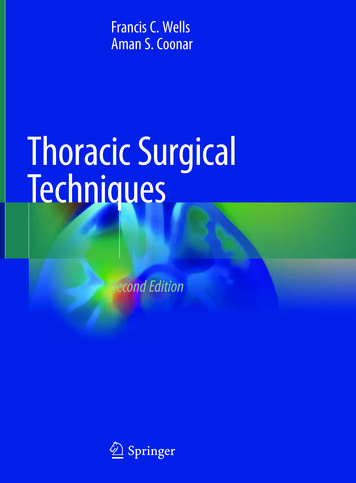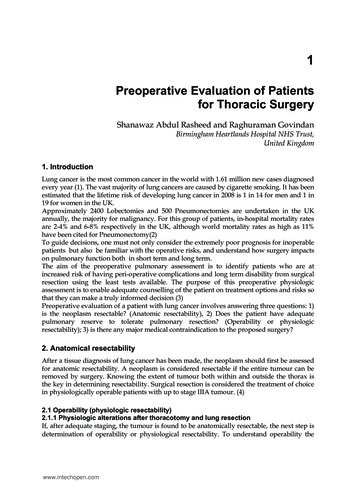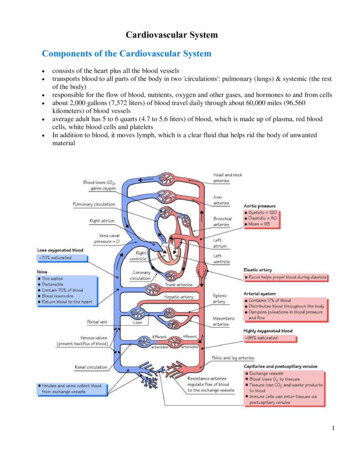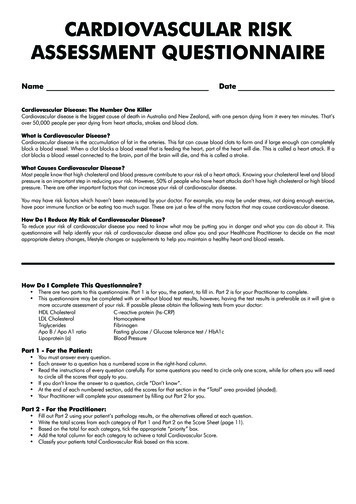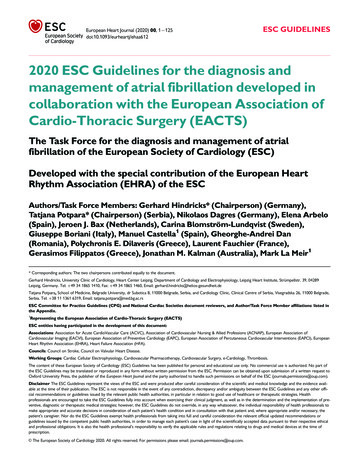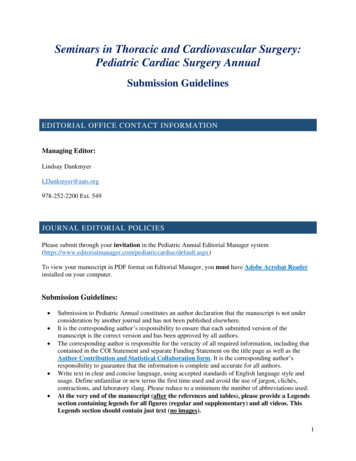
Transcription
Seminars in Thoracic and Cardiovascular Surgery:Pediatric Cardiac Surgery AnnualSubmission GuidelinesEDITORIAL OFFICE CONTACT INFORMATIONManaging Editor:Lindsay DankmyerLDankmyer@aats.org978-252-2200 Ext. 549JOURNAL EDITORIAL POLICIESPlease submit through your invitation in the Pediatric Annual Editorial Manager ardiac/default.aspx)To view your manuscript in PDF format on Editorial Manager, you must have Adobe Acrobat Readerinstalled on your computer.Submission Guidelines: Submission to Pediatric Annual constitutes an author declaration that the manuscript is not underconsideration by another journal and has not been published elsewhere.It is the corresponding author’s responsibility to ensure that each submitted version of themanuscript is the correct version and has been approved by all authors.The corresponding author is responsible for the veracity of all required information, including thatcontained in the COI Statement and separate Funding Statement on the title page as well as theAuthor Contribution and Statistical Collaboration form. It is the corresponding author’sresponsibility to guarantee that the information is complete and accurate for all authors.Write text in clear and concise language, using accepted standards of English language style andusage. Define unfamiliar or new terms the first time used and avoid the use of jargon, clichés,contractions, and laboratory slang. Please reduce to a minimum the number of abbreviations used.At the very end of the manuscript (after the references and tables), please provide a Legendssection containing legends for all figures (regular and supplementary) and all videos. ThisLegends section should contain just text (no images).1
Submission Requirements: Pediatric Annual 2022 Manuscript Manuscript Formatting Title Page Institutional Review Board (IRB)Approval (if applicable) Informed Consent Statement (ifapplicable) Glossary of AbbreviationsCentral PictureCentral MessageAbstractKeywords References Figures and Tables 3,000 word limit (excludes the Central Message, abstract,keywords, references, tables, and legends)The manuscript (including any tables) must be in MicrosoftWord format.Times New Roman 12pt font, double-spacedStandard 1” marginsContinuous line numbering and page numbersTitle – which should be as short but complete as possible.Please do not use abbreviations/acronyms or brandnames/commercial names in titles.7 author limit unless a justification is presented.List all authors’ full names, academic degrees, and affiliation(including institution, department, and division/subspecialty).Conflict of Interest (COI) Statement and separate FundingStatementCorresponding author’s complete contact informationClinical trial registry number (if applicable)Article word count (excludes the abstract, references, tables, andlegends)If applicable, please include the IRB number (and the date ofIRB approval) in two places:1. On the title page2. Within the Methods section of the manuscriptIf applicable, please include a statement regarding the patient(s)’informed written consent for the publication of the study data intwo places:1. On the title page2. Within the Methods section of the manuscriptPlease provide the Glossary of Abbreviations directly after thetitle page.Please reduce to a minimum the number of abbreviations used.Internationally accepted abbreviations such as AIDS, DNA, SD,and TLC need not be defined.Simple, single-frame, color image featuring minimal text.Should illustrate an important central concept of your paper.Central Picture Legend: 90 character limit including spaces.200 character limit including spaces.250 word limit.Provide 3-7 keywords directly after the abstract.25 reference limit – additional references must be designated assupplemental and will appear online only.Please ensure references are in the Journal’s style.Combined maximum of 7 figures/tables for the print version(figures/tables exceeding this must be labeled “Supplemental”).All figures must be in color and uploaded as individualimage files (such as .png, .tif/.tiff, .jpg/.jpeg, or .eps).2
Videos Supplementary Material Author Contribution andStatistical Collaboration FormAuthor Affiliation and Conflict ofInterest/Disclosure QuestionnaireThe Legends section (which must appear at the very end of themanuscript, after the references and tables) must containlegends for all figures (regular and supplemental) and all videos.Tables must be provided in editable Microsoft Word format(not as image files).Videos are requested and must be submitted with a brief videolegend. Videos should be provided in .MP4 format and 400MBmaximum.Supplementary material may be included in the online versionand must be identified (called out) in the print version.Supplementary figures must be uploaded as individual imagefiles, under item type “Supplementary Figure” in the drop-downmenu. Please provide legends in the Legends section of themanuscript.Supplementary tables must be uploaded in editable MicrosoftWord format, under item type “Supplementary Table” in thedrop-down menu. Required at revision; all authors must be included on this form. At receipt of revision, each co-author will receive an email witha link to complete a questionnaire.Revised manuscripts will not be assigned to the handlingeditor until all electronic questionnaires are complete.All disclosures reported via the questionnaire must be reflectedon the title page. FORMATTING REQUIREMENTS-Please submit the manuscript (including tables) in editable Microsoft Word format.-Times New Roman 12pt font, double-spaced-Standard 1” margins-Page numbers and continuous line numberingUnits of MeasurementReport measurements of length, height, weight, and volume in metric units (meter, kilogram, or liter) ortheir decimal multiples. Give temperatures in degrees Celsius and blood pressures in millimeters ofmercury. All hematologic and clinical chemistry measurements should be reported in the metric system interms of the International System of Units (SI). The authors should also add alternate or non-SI unitsbefore publication.11See ICMJE Manuscript Preparation Guidelines3
Figures and Tables (Combined Maximum: 7)Figures:-Color figures are strongly preferred.-Figures must be uploaded as individual image files (such as .png, .tif/.tiff, .jpg/.jpeg., or .eps).-Please do not embed legends into the images themselves. Please avoid dark backgrounds.Tables:-Tables must be provided in editable Microsoft Word format—not provided as images.References (max 25)Limit references to directly pertinent published works or papers that have been accepted for publication.Number references serially in the text and list them at the end of the paper in numerical order.There is a maximum of 25 references. Additional references may be included as a supplementary file andwill appear online only.Reference format should conform to that set forth in the ICMJE Uniform Requirements forManuscripts Submitted to Biomedical Journals. Journal abbreviations should conform to the style usedin the Cumulated Index Medicus. Please see the citation examples below.Citation Format:Journals: Authors’ last names and initials; title of article; journal name; date; volume number, andinclusive pages (list all authors when six or fewer; when seven or more, list six and add et al.):Graeber GM, Gupta NC, Murray GF. Positron emission tomographic imaging with fluorodeoxyglucoseis efficacious in evaluating malignant pulmonary disease. J Thorac Cardiovasc Surg. 1999;117:719-27.Lytle BW, Blackstone EH, Loop FD, Houghtaling PL, Arnold JH, Akhrass R, et al. Two internalthoracic artery grafts are better than one. J Thorac Cardiovasc Surg. 1999;117:855-72.Books: Authors’ last names and initials; chapter title, editor’s name, book title, edition, city, publisher,date, and pages:Mollnes TE. Analysis of in vivo complement activation: In: Herzenberg LA, Weir DM, HerzenbergLA, Blackwell C, eds. Weir’s Handbook of Experimental Immunology. Vol 78, 5th ed. Boston:Blackwell Science; 1997:78.1-78.8.4
KAPLAN-MEIER GRAPHSAll time-varying outcome graphs must meet the following five requirements:1. The x axis must be in years and the y axis must be in percentage (%).2. Please show the number of patients at risk periodically with time.3. The confidence limits must be shown either as bars or as shading. (If necessary and with justification,the confidence limits can be explained in the corresponding figure legend, via a small table embeddedwithin the image, or as a supplementary table). Note: If you display the confidence limits via asupplementary table, this table must be called out in the corresponding figure legend.4. In the legend, please specify the confidence limits (95%, 97%, etc.).5. For each cohort/group, please truncate (stop) the graph lines before the number of patients at risk fallsto fewer than 10 for that group. For patient cohorts that are small to begin with, please end the graphlines before the number of patients at risk falls to less than 10% of the original cohort at risk.BOX-AND-WHISKERS DOT PLOTS (IN LIEU OF BAR GRAPHS)Continuous data should be plotted as box-and-whiskers dot plots rather than as bar graphs. The meaningof the bar, box, and horizontal lines should be defined in the legend. Usually, the upper and lower bordersof the box represent the upper and lower quartiles. The middle horizontal line represents the median. Theupper and lower whiskers represent the maximum and minimum values of non-outliers. Extra dotsrepresent outliers. If the number of subjects or measurements is less than 15, then each of the data pointsshould also be plotted (as different-colored dots).GRAPHICAL ABSTRACTS (OPTIONAL)A Graphical Abstract is a visual summary of a paper that assists readers to quickly identify the paper’smain points. Similar to a pictorial flowchart, this image depicts a paper’s Methods, Results, andImplications, arranged from left to right or from top to bottom. All three areas must be clearlyaddressed: Methods number of subjects (patients or animals) and measurements; Results mainoutcome; Implications how your study can be applied to impact clinical care. At least one colorfulpictorial element (e.g., an illustration or a figure/portion of a figure from the paper) must be included tomake the image “visual.”A built-in descriptive title must be provided at the top of the image. This title must describe the image asa whole so that readers / online viewers can understand the Graphical Abstract independent of the paper.The Graphical Abstract must include an Implications statement (a take-home message). This statementshould explain the implications of the results and/or suggest how the study can be applied to clinical care.Authors commonly provide this statement across the bottom of the image (or on the right side).All abbreviations/acronyms found within Graphical Abstracts must be defined at the very bottom of theimage.5
Graphical Abstract Upload Requirements:Graphical Abstracts MUST be provided/uploaded twice:1. Uploaded as item type “Graphical Abstract” in the drop-down menu (no call-out or legend needed– this is a standalone, online-only image).2. Also included in the manuscript as a regular numbered figure (e.g. Figure 8). Please upload theimage under item type “Figure(s)” in the drop-down menu. Please provide a call-out and fulllength legend (e.g. Figure 8 Legend) that describes, in detail, the contents of the GraphicalAbstract and their significance.-Providing the image twice is necessary for it to appear both online and in print.*NOTE: The numbered figure counterpart to the Graphical Abstract does not count against thecombined maximum allowed of 7 figures/tables.VIDEOS (OPTIONAL)Videos should be uploaded in .MP4 format and cannot exceed 400MB. Videos must be calledout within the body of the manuscript. Each video requires a brief legend (not exceeding 3sentences).INFORMED CONSENT AND APPROVAL BY IRB (INSTITUTIONALREVIEW BOARD) / ERB (ETHICS REVIEW BOARD)The Journal adheres to the principles set forth in the Helsinki Declaration, which requires thatall published reports concerning human participants are conducted in accordance with itsuniversally accepted principles. Reports including information about any data obtained fromhuman participants must contain a statement on the title page and in the Methods section of themanuscript indicating approval by the institutional review board (IRB) or ethics review board(ERB) or an equivalent board. Each paper should indicate that informed written consent wasobtained from each patient to include their information in this publication. If consent was notobtained, the reasons should be provided in the paper. The IRB or ERB decision should beprovided.An explicit statement regarding approval by the IRB or ERB (including the number anddate of IRB/ERB approval) must be provided on the title page and in the Methods section.Additionally, a separate Consent Statement declaring whether the patient(s) providedinformed written consent for the publication of the study data must be provided on the titlepage and in the Methods section.6
PATIENT IDENTIFICATIONIf any patients are identifiable from imaging, illustrations, photographs, detailed clinical data, orcase report information, then the release forms (or appropriate release statements) givingpermission for publication with a written informed consent must be submitted with themanuscript at initial submission. Most reports should avoid identifiable information, whichshould be included only in the very rare instances in which such images are essential to themanuscript.All papers discussing patient data (even retrospectively) must contain a statement aboutinformed written consent from the patient(s).PERMISSION TO REPRODUCE PUBLISHED MATERIALAny image that is not original to the author(s) requires permission to reproduce. The documentsgranting permission to reproduce published material must be uploaded under item type“Permission to reproduce published material” in the submission process. Additionally, the figurelegend should include a statement regarding permissions to reproduce the image.SCIENTIFIC RESPONSIBILITYThe Journal is committed to rigorous peer review, free from commercial influence, in order to promotethe highest ethical and scientific standards in our specialty. Support received from any sources should bedisclosed for each author. The Editors and reviewers will determine whether any of the relationsconstitute a conflict of interest that may have biased the material presented in the paper. Many JTCVSauthors are advisors or consultants for companies that develop innovative technology andpharmaceuticals. Authors with extensive commercial relations provide important contributions to thereaders of the Journal. However, the information must be presented with an appropriate scientific balancethat is unbiased and based on objective assessment of the data. The reviewers and the Editors will attemptto ensure that balance.2In addition to the information about support for the authors, the title page must indicate if the sponsor(s)of the study participated in the study design, collecting, analyzing, and interpreting the data, writing thereport, or deciding whether and where to submit the report for publication. For a manuscript to beaccepted, the authors must attest that they had full freedom to explore the data, analyze the resultsindependent from any sponsor, and had sole authority to make the final decision to submit the material forpublication. The Editor may, if deemed necessary, require a copy of the agreement to verify that thecontract with the sponsor(s) supports these facts.2See the AATS Disclosure Policy and Guidelines for the Editors, Reviewers, and Authors and CardiothoracicSurgical Organizations' Standards for Interactions with Companies7
All disclosure and funding information, including an explicit statement about any potential conflictsof interest (and a separate funding statement) must appear on the title page at the time of initialmanuscript submission.Disclosure PolicyIt is the policy of The American Association for Thoracic Surgery (AATS) that each author of amanuscript must disclose any financial interest or other relationship (grant, research support, consultant,etc.) that he or she (or his or her family) has with any commercial entity that would be affected by thepublication or manufacturer(s) of any commercial product(s) that may be discussed in the manuscript.The AATS has procedures in place if a conflict of interest should arise. In addition, authors must disclosethe discussion of any unapproved use of any pharmaceuticals or medical devices in the manuscript.Policy on Managing Conflict of Interest1. Review of Disclosure Information:The reviewers and Editors of the Journal will review the JTCVS Disclosure of Potential Conflicts ofInterest Questionnaire submitted electronically by the authors. AATS staff may request additionalinformation from authors to expand upon the information presented. Disclosures will be printed withaccepted articles.2. Determination of a Conflict of Interest:The Editors and reviewers will determine whether any of the relationships constitute a conflict of interestthat may have biased the material presented in the paper. In making this determination, consideration willbe given to all relevant factors, including but not limited to: the nature of the manuscript, the magnitudeof the financial interest, and the extent to which the interest may have directly or indirectly affected themanuscript.3. Management and Resolution of Conflicts of Interest:In initial submission, authors must indicate (in the Acknowledgements section) how any conflicts ofinterest were managed in order to avoid bias in the paper. If the Editors determine that a conflict mayhave influenced any part of a manuscript, the author(s) will be given an opportunity to respond and, ifnecessary, to submit additional information indicating how they balanced the conflict. The author(s) willbe encouraged to suggest measures designed to resolve the conflict.At the time of manuscript revision, each author must fully disclose all commercial financial relationshipsvia the electronic questionnaire. It is the Corresponding Author’s responsibility to ensure that alldisclosures reported via the questionnaire are reflected on the title page. Violation of this disclosurepolicy will result in the disqualification of the submission from publication. In addition, authors whoviolate this policy may be denied the privilege of publishing their work in the Journal for two years. Allsuspected violations will be reviewed by the AATS Publications Committee and/or the AATS EthicsCommittee, which will make a recommendation to the AATS Council regarding censure. For furtherdiscussion on managing conflicts of interest please see Sade, Akins, and Weisel “Managing conflicts ofinterest”3 and Sade “The pudding, the beef, and conflicts of interest.”434Sade RM, Akins CW, Weisel RD. Managing conflicts of interest. J Thorac Cardiovasc Surg. 2015;149:971-2Sade RM. The pudding, the beef, and conflicts of interest. J Thorac Cardiovasc Surg. 2015;150:12-38
Authorship and Number of AuthorsThe number of authors should be limited to those individuals who made direct contributions to theintellectual content of the paper. Courtesy authorship is prohibited. For most papers, 7 authors issufficient. Additional authors can be added if their inclusion can be justified and the “Additional AuthorExplanation” section of the Author Contribution and Statistical Collaboration Form is completed with anadequate justification.Each author must assume responsibility for the validity of the results and conclusions in the manuscript.Authors should meet all of the following criteria5:1. Made substantial contributions to conception and design, and/or acquisition of data, and/oranalysis and interpretation of data.2. Participated in drafting and/or revising the paper and provided important intellectualcontributions.3. Gave final approval of the submitted version and any revised versions submitted prior toacceptance.After a manuscript is accepted for publication, no author can be removed from or added to the author list,nor can the order of the authors be changed without the written permission of all of the authors andapproval by the editorial office.In the case of a working group, the group title must be included at the end of the author list with thecatalogue of the additional contributors provided in the format below (this is necessary for PubMed to listthe group members under “Collaborators” as part of the article record). These authors will then have thepaper listed under their names as authors. The group name must be included in the author byline appearing after the individual authors, e.g.,“John Doe MD, Sarah Smith MD, and the XYZ group.”There must be a corresponding footnote on the title page that either lists the names of theindividual group members or indicates that the individual group member names are listed at theend of the article.Please note: The limit on the number of authors will remain at later revision stages as well. Please see thespecific article type submission requirements for author limits.Copyright StatementThe transfer of the copyright will be requested by the publisher, Elsevier Inc., after manuscriptacceptance. Please respond promptly to its request and complete the form agreeing to the transfer of allcopyright ownership of the manuscript to The American Association for Thoracic Surgery (AATS). Bycompleting the copyright, authors warrant that the article is an original work without fabrication, fraud, orplagiarism; does not infringe on any copyright or the proprietary right of any third party; is not underconsideration by another publication; and has not been previously published. Authors also warrant thatthey each meet the requirements for authorship enumerated in the Journal's Information for Authors5See Consensus statement on surgery journal authorship-2006. J Thorac Cardiovasc Surg. 2006;131:1221-29
(above) and understand that if the paper or part of the paper is found to be faulty or fraudulent, eachauthor shares the responsibility. While copyright is transferred to the AATS, the Journal and Elseviersupport responsible sharing. Find out how you can share your research published in Elsevier journals.Authorship of EditorsEditors of the Journal may submit manuscripts for consideration for publication in the Journal. WhenEditors of the Journal are authors or co-authors on manuscripts they are completely excluded from theeditorial and peer-review processes for the manuscript. If the manuscript is accepted for publication theJournal will include a statement disclosing that one of the authors is an editor and was excluded from thepeer review and editorial evaluation of the manuscript prior to acceptance.REVISED MANUSCRIPT SUBMISSIONRevised Manuscript FilesTwo Word files must be submitted for revised manuscript submissions:1. Marked revised manuscript Word file showing additions and deletions, preferably usingstrikethrough format for deletions and red font for insertions.2. Unmarked revised manuscript Word file.Point-by-Point Response to Editors’ and reviewers’ CommentsA Point-by-Point Response to the Editors’ and reviewers’ comments indicating what changeswere made to the manuscript must be submitted in the appropriate place in the submissionsystem. For each comment, the authors MUST provide the following three items:1. The verbatim individual comment by the Editor or reviewer (please separately list eachcomment).2. Your response to the comment3. What changes were made (with line numbers denoting where the changes can be foundin the Marked Copy) – or explain why no changes were made.10
Author Contribution and Statistical Collaboration FormThe Journal requires the Author Contribution and Statistical Collaboration form besubmitted with all revised original manuscripts. This form must detail the substantivecontribution(s) of each author. The form must also indicate either that the paper contains nocomplex statistics (no comparisons were made) or that the paper has been reviewed by acollaborating or consulting individual who has the appropriate training and experience inbiostatistics. Please provide the name, institution, department, email address, and area(s) ofstatistical expertise of the biostatistician expert who should either be an author or acknowledgedas a consultant for the paper.Author Affiliation and Conflict of Interest/Disclosure QuestionnaireAt the time of revision, each author will be emailed a link to complete a required questionnaire.Authors must confirm their authorship and report any potential conflicts of interest/disclosures(personal fees, funding, patents, etc.) Authors must fully disclose all commercial financialrelationships.The corresponding author is responsible ensuring that all authors report their potentialconflicts and that all conflicts/disclosures reported via the questionnaire are reflected onthe title page. If any conflicts exist, a statement must be provided in the Acknowledgementssection of the manuscript detailing how the conflicts were managed in order to avoid biasin the paper.Order of AuthorsAll author listings must be identical and consistently up to date. The order of authors asprovided on the title page must match the order of authors as inputted into the Editorial Managersystem. At revision, please ensure that any changes to author listings are made consistentlyacross the entire submission package (including the Author Contribution and StatisticalCollaboration Form).11
Institutional Review IRB approval)Board (IRB) Approval (if applicable) 1. On the title page If applicable, please include the IRB number (and the date of in two places: 2. Within the Methods section of the manuscript Informed Consent Statement (if applicable) If applicable, please include a statement regarding the patient(s)'
